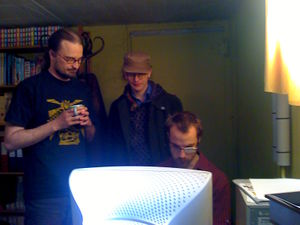
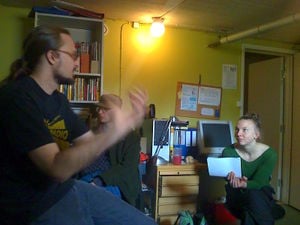
16.04.2010 Mikko, Markus, Minta, Ismo, Annette
Dates[edit | edit source]
- The First Workshop was held at 15th of May
in Werstas as part of the Night of Museums Campaign Partner: Luonto-Liitto Open Doors Day (free) Theme: forest relationship of city dwellers (e.g. audiance of the videos)
- Second Workshop could be between 26.5. - 9.6.
Target Group: Luonto-Liitto Place? Theme: Forest Conflicts in North - expreciences, conflict solving methods and ideas to apply them in Second Life
- Third Workshop 9.-15.6.
Target Group: Open for all Theme: Virtual protest
Place[edit | edit source]
first workshop:Café of Werstas Museum or the lobby area 2nd workshop:? 3nd workshop: Werstas
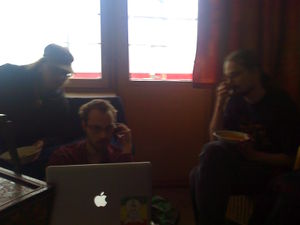
Duration of WS[edit | edit source]
2 - 4 hours Same time with the Luonto-Liitto's video screening
From 6 to 10
To do[edit | edit source]
- call the person from Luonto-Liitto, best time: Mikko
Aims[edit | edit source]
- to get content clear for Dortmund (maps, virtual world platform): explore it with people
- to connect new people into the project to know how wiki, second life works
- good impression in Dortmund
- videos about finish forest conflicts shown by Luonto-Liitto - ws should be the conversation part of it
- what are the important issues about forest: get informations about topics and things to do: ask "what should be done?", "is second life useful at all, how?",
- find out: relationship people - forest in Tampere (distance as an aspect, we are dealing with it in the project, urban and rural view)
- no stereotypical views
- concerns of the city folk: questions
Topics[edit | edit source]
- studying forest ownership, how do they use it?
- all man's right; who guards the land? uses it?
- forest conflicts in the city?
Targetgroups[edit | edit source]
- young people up to 28 years (= technical aspects second life teens) See Second Life
- people in our organisation
- other nature organisation DODO
http://web.archive.org/web/20110302200703/http://dodo.org:80/tagit/tampere
- may be people who come along by accident, want to have a look on what's going on (museum day)
Methods[edit | edit source]
- story telling
- Collecting new media stories like Harvester / moto youtube videos; reminds of Iraq and tank film with hard music (70 000 views of the moto film)
Report of the First Workshop in Werstas 15.5.[edit | edit source]
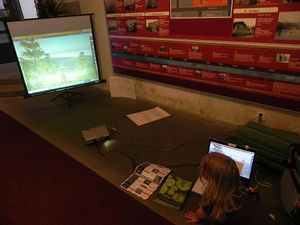
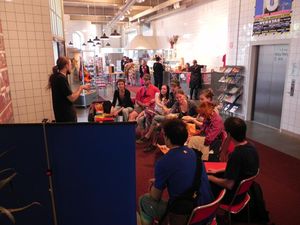
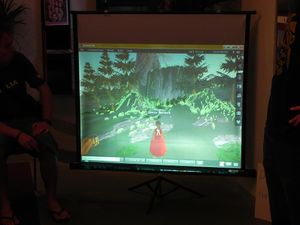
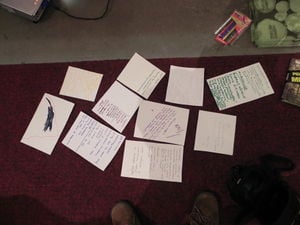
People organizing the workshop: Mikko Lipiäinen, Markus Petz, Ismo Torvinen, Suvituulia Huotari
The first workshop was held in Werstas lobby immediately after Luonto-Liitto's video screenings at 20.30. Our original idea was to offer a possibility to the screening audience to discuss about what tey have seen. Despite the fact that there were some 20 people in the audience only one of them attended the workshop. Fortunately Markus managed to invite a group of Couch Surfing people to participate. In the end there was over 10 people attending. Also one 5 years old child showed lot's of interest and drawed even a picture of his experience in the virtual forest.
There was lot's of people passing by and Mikko got some opportunities to explain the project to museum visitors, also to few teenage boys who were mainly interested about the technical side but also about the concept. They got interested about the forest conflicts and how our project could be used for solving them. They asked detailed questions about actual examples of recent conflicts. Mikko used Nellim's (a place in Upper Lapland) conflict between reindeer herders, foresters and Greenpeace as an example.
In the workshop Mikko introduced the Virtual Forest Conflict Sites project by explaining it briefly and demonstrating the use of Second Life and how the projects first virtual forest was built. A data projector, screen and laptop was set up to allow the use of Second Life and the projects own virtual land area in it. After demonstrating the use of Second Life Mikko asked participants to describe a Finnish forest and it's most important values. This task was selected because of the strong international nature of the group. How was the Finnish forest seen internationally? After that there was another pair of questions: Describe a stereotype of sami people and write a list of things you would like to know about them. These questions were related to a discussion about (international)media's way of representing indigenous people (Sami compared to Canadian first nation people etc) and how new media could be used bring new kind of voices to the mediasphere.
The workshop was built thematically around a conflict illustrated in one of the videos shown in the Luonto-Liitto's screening. The video was Last Joik in Sami Forest directed by Hannu Hyvönen. In the conflict Greenpeace placed a steel container in endangered forest that was important for sami reindeer herders. The container was named as Forest Rescue Station. This all was part of Greenpeace's media campaign. Soon after that another camp erected nearby. It was called Anti-Terror Info Center and was initiated apparently by local foresters. In the document one can see how people from Anti-Terror Info Center harass Greenpeace and sami activists by using loud music and machine noises, abusive language and behaviour and threats. In one picture one can see a sign that says:"Greenpeace=Al Quaida". This conflict was selected for the workshop because fo is traumatic impact to Finnish audience and local people. It was also a good example because many innovative, easy to understand and theatrical methods were used by both Greenpeace and sami activists and anti-Greenpeace group during the conflict. For the workshop we managed to create a model of Forest Resque Station to Second Life and some signs that provoked some discussion during the workshops.
Mikko's feedback about the workshop:
- The video screening and the workshop didn't work together well. Reasons for this could be the late time and the hectic atmosphere of the Night of the Museum. Also the idea to change the room after watching the films could've been an obstacle for many viewers. Maybe people were ready to discuss but we interrupted the process by asking them to move to another place?
- The themes of the shown videos and the theme of the workshop worked very well together. The one and only participant that joined the workshop after watching the films was provoked by the last film showed, Sateenkaaren päässä and wrote about her experience of seeing her childhood's forest devastated. This material could be useful for our project in future.
- Workshop's international audience was excellent. We got a rare possibility to evaluate the image of Finnish forest by non-Finnish participants. The end result was that in future we should emphasize the global dimension of the Finnish and Nordic forest conflicts. It was interesting to find out that all man's rights was one of the most frequent terms or ideas when participants described the most important values of the Finnish forest.
- In overall the workshop gave confidence to continue with ideas of applying drama and theatre of oppressed methods in our projects. It seems that in Second Life one can effectively tell stories about social conflicts and power relations. Also the sense of shared space (or stage) is quite strong in Second Life. This could be an important factor when building solidarity gatherings in Second Life.
Text collected from the workshop participants
sheet 1. Tourism: helps -> improves nature
friendliness in society harms-> impact of hikers is unavoidable paper industry: sustainable? (if forest is not decrbasing)
sami: more culture
and business representation (share in forest industry)
sheet 2. (describe the finnish forest:) clean big animals living in the wilderness finnish forests are close to any urban settlement
Zotlán Görög (Yes,)
sheet 3. (describe the finnish forest:) majestic peaceful captivating wonderful dirty!!!
sami people: i have a naive understanding s i am unable to create a stereotypical view or opinion of sami people
sheet 4. (describe the finnish forest & most important values of finnish forest:) piilopaikka sienikellari
pyhäkkö, hiljaisuuden retriitti
- moniulotteisuus,syvyys.
- vuodenaikojen ilmenemisen "paikka"
sami: stereotypia: (piirretty kuva nukennäköisestä ihmishahmosta neljäntuulen lakkiin ja saamelaiseen perinnepukuun puettuna)
mitä haluaisin tietää?
- miten he ovat erilaisia kuin "me" ?
- millaisena he näkee meidät, tai lähinnä itsensä suhteessa meihin muihin?
- millaisia tarinoita heille kerrottiin lapsena?
- millaisia lauluja he laulaa?
- mitä toivovat, mitä pelkäävät?
sheet 5. (describe the finnish forest & most important values of finnish forest:) untouched wondering around going from the normal paths picking berries/mushrooms forest as commercial area
- >harvest
- >tourism
living simpler life open/accessible to all
sami: stereotype
- having reindeers
- living simple life
want to know
- how they adapt to modern society
sheet 6. (describe the finnish forest & most important values of finnish forest:) suomalainen metsä on... ...useimmissa paikoissa yksipuolista talousmetsää ...kaikkialla, kaupunkienkin lähellä on aina metsää esim. kauppi pyynikki ...metsässä on marjoja, sieniä, eläimiä, hyttysiä
TÄRKEÄÄ ON jokamiehen oikeus, kaikki saavat nauttia metsästä myös suoluonto ja suomalainen metsä on tärkeä suojella
sami: stereotypia on pulttiboisin nunnukanunnuka ukot
haluaisin kuulla saamelaisten ajatuksia luonnosta
sheet 7. AVOHAKKUUALUA
lapsuuden maisema:
- puutarhaviljelmän omaista
- metsä oli vieressä
- jylhiä kuusia (toisaalta turvallisia, toisaalta pelottavia)
avohakkuuoja tulehtunut, märkivä haava äitimaan ihossa... uhka tulevaisuudelle! loukkaus jokamiehen oikeuksia kohtaan! no ni, "moottoritie" on jo täälläkin kylätien sijasta (n.70 kilsaa jyväskylästä itään aiemmin upeiden vanhojen metsien keskellä) tätä rumuuden voitto- kulkua, VOI EI. RAHA HAISEE.. RAHA PUHUU!
sheet 8. (describe the finnish forest & most important values of finnish forest:) finnish forest=important->a calming place (a drawing of a bird)
- fresh, clean air
- trees (different kinds)
- birds singing (a drawing of a mushroom)
- squirrels
- berries & mushrooms
- clean water (for also drinking)
- strong part of identity
sami: "saamelaiset" stereotypes...
- traditional clothes
- different language
- no modern technology
- reindeers
- >would be interesting to see their everyday life
sheet 9. (describe the finnish forest & most important values of finnish forest:) quiet clean refreshing beautiful
sami:
- wearing the national costume
"kansallispuku"
- "harrastaa" poronkasvatusta
Report of the Second Workshop with Luonto-Liitto 7.6.[edit | edit source]
There was only one person from Luonto-Liitto attending the meeting in the end. In the workshop the basic idea of our Second Life site was explained and some ideas of the possible architecture of the site was discussed.
Basically there were two possible directions to continue the project:
1. Closer co-operation with Luonto-Liitto. This could mean focusing on the Luonto-Liitto's inventory trips to endangered forest areas and use the material based on these trips for building the Second Life site.
- There are already lots of material varying from pictures, maps, diaries etc. provided by Luonto-Liitto.
- This direction would fit well into the original plan (https://www.appropedia.org/Synopsis_Virtual_Forest_Conflict_Sites) which stated:
"The spaces are based on disputed maps and satellite pictures of forest conflict sites in the Northern hemisphere."
- In any case it would be useful to get a better picture what kind of info there is available through Luonto-Liitto
Problems:
- language, only in Finnish (?)
- Too limited to one participant, against the original idea:
"Visitors of the virtual sites can study the virtual environment and interact with others, including the forest activists and other participants of the conflicts who are invited to provide up-to-date information and an insight to the selected conflicts."
2.Offer the Second Life space to several orgs and individuals by using a metaphor of a camp
- Would fit within the original idea:
"Visitors of the virtual sites can study the virtual environment and interact with others, including the forest activists and other participants of the conflicts who are invited to provide up-to-date information and an insight to the selected conflicts."
- Would actually create a representation of northern forest as something social and full of conflicts in a natural way. We now know that Second Life is not the best place to depict the natural environment photo-realistically, so it's a better idea to focus on the social level.
- The camp metaphor is easy to understand to both visitors and the active participants of the project. It gives the private space for the invited orgs/groups and the space between different camps can be used for example to tell about the differences between different groups.
- This method creates a game like situation where different camps try to get as much attention to their cause during the exhibition. So the groups could be easily motivated?
- Groups and orgs could provide information easily by using RSS-feeds and other technologies that connect Second Life and other Internet media such as Facebook, blogs, Flickr etc.
Problems:
- Not anymore maps-related, but then again we have had problems to connect the Second Life site to the real geographic locations anyway.The connection to the real sites could be still done by the participants if they wish so.
- Language. Should everybody invited provide at least some info in english? We know that some like Greenpeace are already multilingual so they are in a better position compared to for example Inarin Paliskunnat that has not so good resources for providing stuff for international audience.
- This method could create a publicity that would be open for all kind of voices, also those that are against forest preservation? A problem? In the other hand, this method is anarchist in nature handing the responsibility to the ones that provide the information. This means multiple voices that are disagreeing with each others=good for the project (bad for the rescuing the forest?)
- moderating the site
Mikko's view
I like the 2dn way of proceeding better since it could create interesting results, not only use Second Life as propaganda machine. The original idea stated also:"Many independent activist-run web-projects have brought to our consciousness voices from the forests. These voices have traditionally been silenced by corporate mass media. They include biology researchers, ethnic minorities, indigenous people and various groups for social and environmental justice. What will happen when forest conflict sites are expanded to virtual reality, which allows new kind of participation for those who cannot be on the physical site? Can Second Life's culture of playful fantasy give us new tools for resolving conflicts, for challenging the authority based on formal expertise and for dealing with the growing global anxiety caused by the way developed countries are destroying our planet's natural resources? ". This way of proceeding could support this in an interesting, game like way.
Other stuff:
- Huts in the woods
- remember Luonto-Liitto's blog! Maybe we could use it?
Markus's view
There could be more options. I talked a little with Mikko and Sari. From those talks I think that the second option sounds better. I like the idea of having an e-distro where general info can be put as RSS feeds and then in the camp we can try and get NGOs from the different countries (Such as Robin Wood - Deutschland, Woodland Trust - England etc.) to put things into. There were 2 ways of seeing this.
1 As one big activist area where people share and its all in common. This is problematic if we want gvt, forest industry participation. It also can make it difficult for NGOs to have different approaches.
2 Each NGO being limited what they can put in the e-distro, but then they can develop what they want in their own space on our land. thus we can have common areas where different sectors and individuals can interact. So this would allow for example Greenpeace to be there and also Hirvitalo and Luonto Litto without feeling that the habitus is set by someone else. They can each have their own habitus and also corporates can have their own corporate culture (for example a board room).
I felt the first option (Closer co-operation with Luonto-Liitto) tends to a more scholarly, naturalist / scientist approach. So far we have not had much input from Luonto Liitto and I fear this will be so in the future. It tends to art installations - not really what we want to do in this exhibition.
I believe the second option (Offer the Second Life space to several orgs and individuals by using a metaphor of a camp) fits more with our artivist approach and interest. I think it will be better done, and I think that its less reliant on one NGO. It also allows us to do stuff for different countries. I also think the its activist related: the aim of the exhibition space. And it uses new technology.
LONG Dramaturgy for a sheet to be printed for the installation[edit | edit source]
Here is the full dramaturgy for the Foreigners Finnish Forest(unedited as a scratch document)
Ulkkomalasiten suomen metsä -a foreigner's finnish forest.
FOREIGNER? WELL AS A PERSON THAT DID NOT GROW UP IN FINLAND I AM A FOREIGNER. BUT I DID GROW UP IN NORTHERN EUROPE AND IN A SECULARIZED CHRISTAIN COUNTRY IN A RURAL AREA – SO I DO HAVE THAT PERSPECTIVE.
I came to Finland
FIRST TIME I CAME I DID SAUNA AND STAYED IN AN OLD PORT AREA, AND WALKED A VERY LITTLE ON THE COAST – I DID NOT GO TO ANY LAKES OR WILD FOREST AREAS. I ONLY KNEW THE FINNISH WORDS PERKELE AND SAUNA.
and had heard tell of the Northern landscapes
ITS NORTHERN TO ME, ALTHOUGH I GREW UP IN NORTHERN EUROPE, IT WAS NOT NORDIC EUROPE, WHICH SEEMED EVEN FURTHER NORTH, AND SO COLDER, WILDER AND MORE REMOTE, UNCIVILIZED AND BARBARIAN.
betwixt the land of 10 000 lakes.
THIS IS HOW I THOUGHT OF IT, LIKE THE FENN LANDSCAPES YOU FIND IN FLAT LANDS AT THE END OF RIVERS
I heard the music of Korppi klaani and in me it conjured up the idea of how the forest should actually be. SO THIS IS THE WILD WOOD – AN ANALAGY IS JETHRO TULL'S Songs From the Wood – but korppi seems wilder a place where wolves live and people do not, WOOD – MESTSÄ -seems a place that is created by man KÖRPPI – a place man comes into and is there without him, like a FIELD compared with a PRARIE. Or a CANAL with a RIVER
This is a conflict when juxtaposed against the practical resource use of the forest as seen by those (finnish? Suomaliset?)
I DO NOT SEE THESE AS THE SAME, NOT EVERYONE who is in finland is finnish? Immigrants like me are not, there are some recognized minorities (like the ROMA – here since 15th c) and SAMI – and SWEDISH which all seem different. Maybe these distinctions are not clear to a finnish person. BUT if you think of Britain (ENGLISH, WELSH, SCOTTISH – or even Saxon, Dane, Norman, Cornish) or more modern LONDON and MERCIAN or YORKSHIRE MAN – you can see a complexity. SO HERE THERE ARE DIFFERENT CULTURES WITH THESE DIFFERENT IDENTITIES – I SEE THEM, WITH MY PERSPECTIVE, PERHAPS YOU DO NOT. AND ALSO THERE ARE CONSEQUENCES; FOR EXAMPLE IN THE CONTEXT OF FOREST USAGE RIGHTS – IF YOU ARE SAMI THE GOVERNMENT TAKES AWAY YOUR RIGHTS WITH THE STRICT FINNISH FOREST NATURE PRESERVES, BUT ITS NOT YOUR GOVERNMENT ITS A SUOMI NOT A SAMI GOVERNMENT. SIMILARLY THE USE OF THE WOODS FOR REINDEER FODDER REMOVES THE SUOMI PEOPLE'S EVERY MAN'S RIGHT TO HAVE A PROTECTED COMMON STANDARD FOR THE WOODS. HOW DOES THIS DYNAMIC PLAY OUT IF MOST SUOMILAISET LIVE IN THE SOUTH AND MOST SAMILAISET IN THE north? What about when the press refferes to soumalaiset (as a catch all term for those living in finland?) does that include the minorities, or swallow them up and hide their differences? Do you like representative democracy or participative democracy?
. How is there a conflict in the cultural perceptions in my romantic
ROMANCE – COMES from the old french "mettez en romanz" - to put into romanz. Romantic is also related to the romantic art period
"Romanticism or Romantic Era is a complex artistic, literary, and intellectual movement that originated in the second half of the 18th century in Western Europe, and gained strength in reaction to the Industrial Revolution.[1] In part, it was a revolt against aristocratic social and political norms of the Age of Enlightenment and a reaction against the scientific rationalization of nature,[2] and was embodied most strongly in the visual arts, music, and literature, but had a major impact on historiography[3], education[4] and natural history.[5] The movement validated strong emotion as an authentic source of aesthetic experience, placing new emphasis on such emotions as trepidation, horror and terror and awe—especially that which is experienced in confronting the sublimity of untamed nature and its picturesque qualities, both new aesthetic categories. It elevated folk art and ancient custom to something noble, made of spontaneity a desirable character (as in the musical impromptu), and argued for a "natural" epistemology of human activities as conditioned by nature in the form of language and customary usage. " SO I HAVE A ROMANTIC VIEW AS ITS ONE SHAPED BY PERCEPTIONS AND IMPRESSIONS, NOT WHAT I HAVE ACTUALLY SEEN IN THE FORESTS – IT CAN STILL BE ACCURATE
(pagan I AM NOT AMBRAHAMIST, BUT PAGAN ALSO MEANS COUNTRY TRADITION FROM Latin paganus
view point as shaped by wicca
I AM WICCAN "Its disputed origins lie in England in the early 20th century," http://web.archive.org/web/20170311095555/http://www.witchvox.com/va/dt_va.html?a=ustx&c=basics&id=11793
and my western
SO EUROPEAN CULTURE THAT IS WEST EUROPE "WESTERNIZED" (http://en.wikipedia.org/wiki/Westernisation)
note I DO NOT MEAN DECADENT, OR COLONIAL ETC. BUT NOT AFRICAN, NOT EASTERN BLOC, BUT am filtered thru books, media songs that are reaching beyond Finland's shores.
imagining of it/ I am also a biologist BIOLOGY / GEOLOGY DEGREE FROM MANCHESTER UNI (A GOOD ONE)
so have some awareness of how a forest actually is
BY LOOKING AT PICTURES, READING SCIENTIFIC JOURNALS, TALKING WITH FOREST EXPERTS, FIELD TRIPS, DISCUSSIONS WHILE A WARDEN OF A NATURE RESERVE, DOIMNG VOLUNTARY RESERVE MANAGEMENT WITH wildlife trust
rather than how its imagined to be
books ARE ALSO SELECTIVE – LOOK AT EUGENICS, WHAT FOREST CASES ARE TAUGHT, WHO WRITES THE TEXT BOOKS – DO THEY WRITE WONDER BOOKS OF NATURE? OR PLANTATION MANAGEMENT AND CAPATALISTIC EXPLOITATION (SEEN AS GOOD) BOOKS
http://www.slideshare.net/esagor/growing-and-tending-your-forest-an-introduction-to-silviculture
Growing and Tending Your Forest: An introduction to silviculture
) and the cultural expectations of an old growth forest as expected of a suomi resident?
SO OLD GROWTH IS? ; "Old-growth forest (also termed primary forest, ancient forest, virgin forest, primeval forest, frontier forest or in Britain, ancient woodland) is a forest which contains trees which have attained great age (and associated structural features) and so exhibits unique ecological features[1]. Old-growth forest typically contains large and old live trees, large dead trees (sometimes called "snags"), and large log. Individual tree mortality creates gaps in the main canopy layer, allowing light to penetrate the main canopy and create favorable photosynthetic conditions for the understory (which is why old-growth understory is more developed than in immature stands)." http://en.wikipedia.org/wiki/Old-growth_forest "Ancient woodland is a term used in the United Kingdom to refer specifically to woodland dating back to 1600 or before in England and Wales (or 1750 in Scotland). Before this, planting of new woodland was uncommon, so a wood present in 1600 was likely to have developed naturally.[1] For many species of animal and plant, ancient woodland sites provide the sole habitat, and for many others, conditions on these sites are much more suitable than those on other sites. Ancient woodland is the UK's equivalent of rainforest, home to more rare and threatened species than any other UK habitat. For these reasons ancient woodland is often described as an irreplaceable resource, or 'critical natural capital'.[2]"
http://en.wikipedia.org/wiki/Ancient_Woodland
The question of nationalism and acculturation comes in here. So for example do you see waste woodland? unproductive woodlands which needs treating some-way to be productive? or a stand of timber ready for paper making? Do I see it as a spiritual place with an energy in it?
http://books.google.fi/books?id=kCgyt6Ty8gYC&dq=skogen+robert+holdstock&source=bl&ots=E6_TQt07iq&sig=0HssNX338De_fQCgWCHk1kQ2N2g&hl=fi&ei=cL3iS8_TDoKlOKjE3dsN&sa=X&oi=book_result&ct=result&resnum=1&ved=0CAkQ6AEwAA - Skogen A haunting entry in the World Fantasy Award-winning Mythago Cycle InMythago Wood, Robert Holdstock gave us an intricate world spun from the stories of Irish and English mythology, a great forest steeped in mystery and legend, whose heart contains secrets that will change all who behold them. Young Tallis is one such seeker. When she was just an infant, she lost her brother Harry to Ryhope Wood. Her adolescent fancies now cause her to suspect that he is still alive---and in grave danger. Tallis follows Harry into the primal Otherworld armed only with magic, masks, and clues left by her grandfather. Eventually the primitive forest gives way to Lavondyss itself, a fascinating and terrible realm where she is forced to confront the mythagos, physical manifestations of the legends of humanity's collective unconscious. Join Tallis on her quest into the ultimate unknown, and be invited into one of the finest and most compelling mythologies you will ever encounter. "A stunningly good book... conveys the haunting power of old heroes and lost gods." --Locus "Magical... It is rare to find a sequel which measures up to its original; but Lavondyss surpasses it." --Times Literary Supplement SO HOLDSTOCK REFLECTS WHAT IS IN THE COLLECTIVE CULTURAL MYTHOS OF ENGLISH CULTURE NOW. SO I WILL HAVE SIMILAR THINGS (YOU CAN SEE THIS TOO WITH HARRY POTTER – THE SETTINGS, ARRANGEMENTS, MONSTER CHARACTERISTICS ETC. - ARE ALL IN ENGLISH COLLECTIVE UNDERSTANDING, HENCE THE DIFFICULTY TRANSLATING TO OTHER LANGUAGES)
also problem of transformation
The Problem of Transformation: The Use of Medieval Sources in Fantasy Literature Michael D.C. Drout 1 1 Wheaton College, Norton, MA Copyright © Blackwell Publishing 2004 ABSTRACT This paper examines the ways that contemporary authors have transformed medieval source materials in fantasy literature. Three types of transformations can be identified: Type 1, in which authors transform medieval material without noting or acknowledging it in their text, but without making any efforts to disguise the source; Type 2, in which authors point out their sources and discuss their modification; and Type 3, in which the sources are either disguised or not recognized by the author. Examples of Type 1 include the works of J. R. R. Tolkien and Susan Cooper's The Dark is Rising books; Type 2 includes T. H. White's The Once and Future King; Ursula Le Guin's Earthsea books are an example of Type 3. Each type of transformation creates a slightly different kind of irony: readers of the story have more information than the characters inside the story. This irony can be used deliberately by the author, and it can also be an unintended by-product of the use of medieval sources. The use of different types of transformations may explain the aesthetic success of works like those of Tolkien, Le Guin, and White. Transformation of medieval sources is also worth studying because many readers only encounter medieval materials through their transformation in fantasy literature.
Is it welcoming (RESEARCH SHOWS THE SEEING GREEN AND EXERCISING IN IT IS CALMING) or frightening (WE NATURALLY FEAR THE STRANGE AND DARK) ? OR neutral? (IS A LEAF BY ITSELF ACTUALLY GOING TO CAUSE EMOTIONAL RESPONSE?)
How we see these perspectives will often shape culturally the object s we will see in a place. (there is the tale of native americans taking some french - europeans on a boat trip - during the boat trips many things were seen, after the trip the trip was related by both the europeans and the natives of the area. The europeans replied with nothing was seen - it was all a wasteland to them and the natives pointed out the food that could be eaten and the trees for building canoes) So in the case of this OLD GROWTH forest: I see a spruce (Norway Spruce (Picea abies) is a species of spruce native to Europe. It is also commonly referred to as the European Spruce.)
and see it as a source of nostalgia at Xmass – (IT DOES NOT NATURALLY GROW IN THE UK) v the green tips not noticed before that you see as a food source or even for making tea. I see it more as making firewood, so big trees are noticed and small bushes are not.
So here is a cultural difference - to me the forest is a harsh place (so wild and untamed) to be survived and this the use of the things, but to you the survival is a given so instead you look for secondary uses of the trees production (its part of your existence). (FOLK USES OF PLANTS COME IN HERE) So here is a description of a forest (AN old growth forest as I imagine it - with purely physical characteristics) "SO what is a an old growth forest To me an old growth forest NB I SAY old growth – not ancient woodland, and forest not wood.
is one that has not been touched by the activities of man
A PRACTICAL impossibility, SO I mean land management rather than climatic affects
. So there are no paths through the forest
OR CLEARED PATHS, animal trails may exist, also ley lines or song lines. Its impossible to go through the forest and leave no record "leave nothing but footprints" - will lead to broken twigs, flattened moss etc.
, every so often there are glades (clearings in the forest) AUKIO
A glade is an open area within a woodland. Glades are often grassy meadows under the canopy of deciduous trees such as red alder or quaking aspen in western North America. They also represent openings in forests where local conditions such as avalanches, poor soils, or fire damage has created a semi-permanent openings. They are very important to herbivorous animals, such as deer and elk, for forage and denning activities.
where an old tree has fallen down and the rotten logs are covered over with beetles
(ARE IN FINLAND)
and wood-lice (NOT SO IN THE CULTURE AS IN UK AS RELY ON DAMP, Ruskomäntypistiäinen are more common here – so its siirat are woodlice)
http://en.wikipedia.org/wiki/List_of_woodlice_of_the_British_Isles 35spp native
. As time goes on many of them are covered over with moss (Lehtisammalet - plant) and some lichen (green alga + fungus symbiont). There is much of this reindeer moss or lichen
Cladonia rangiferina http://en.wikipedia.org/wiki/Reindeer_moss Poronjäkälä
of a slightly stringy nature like an antimacassar or doily hanging from the trees. Growth form Lichens are informally classified by growth form into: crustose (paint-like, flat), e.g., Caloplaca flavescens filamentous (hair-like), e.g., Ephebe lanata foliose (leafy), e.g., Hypogymnia physodes fruticose (branched), e.g., Cladonia evansii, C. subtenuis, and Usnea australis leprose (powdery), e.g., Lepraria incana squamulose (consisting of small scale-like structures, lacking a lower cortex), e.g., Normandina pulchella gelatinous lichens, in which the cyanobacteria produce a polysaccharide that absorbs and retains water.
In the forest are some streams
http://en.wikipedia.org/wiki/Stream actually brook is better word - puro
where the trees have been blocked and so small ponds may have formed. Ground cover
In an ecosystem, the ground cover is the layer of vegetation below the shrub layer. The most widespread groundcovers are grasses of various types.
is a carpet of needles and small sticks. There are many sticks with moss grown over them, so only a bit of lichened stick comes thru. The forest is not flat, but is very bumpy with up to 2m rises and falls where branches or tree trunks have fallen and then been grown over. So its quite difficult to walk thru. THere are low down branches, but not so many as the higher branches cut out some of the light they' live off. The branches may be at waist height so you cannot just walk thru, but have to go around, or climb over.
The forest is not silent for the sound of a woodpecker can be heard and also the occasional cry of a metsö or capercaile. The forest is not wet like a swamp, but its damp under the moss and lichen. The moss covers over much of the kalliot (rock outcrops that stick up) and there are commonly brown pine needles that have fallen off the pine trees. Some of these have been collected by ants that make anthills, The ant hills are not dominating all of the forest, but they are quite large maybe 1 and a half meters
"Causes of plant succession Autogenic succession can be brought by changes in the soil caused by the organisms there. These changes include accumulation of organic matter in litter or humic layer, alteration of soil nutrients, change in pH of soil by plants growing there. The structure of the plants themselves can also alter the community. For example, when larger species like trees mature, they produce shade on to the developing forest floor that tends to exclude light-requiring species. Shade-tolerant species will invade the area. Allogenic changes are caused by external environmental influences and not by the vegetation. For example soil changes due to erosion, leaching or the deposition of silt and clays can alter the nutrient content and water relationships in the ecosystems. Animals also play an important role in allogenic changes as they are pollinators, seed dispersers and herbivores. They can also increase nutrient content of the soil in certain areas, or shift soil about (as termites, ants, and moles do) creating patches in the habitat. This may create regeneration sites that favor certain species."
wide and upto a meter tall. But if you were to sit still you would see soon ants, or beetles or maybe flies buzzing through the forest. here are not so many birds. Time of day matters.
Ants thrive in most ecosystems, and may form 15–25% of the terrestrial animal biomass.[8] Their success has been attributed to their social organisation and their ability to modify habitats, tap resources, and defend themselves. Their long co-evolution with other species has led to mimetic, commensal, parasitic, and mutualistic relationships.[9]
The forest is mostly still, if you still yourself and close your eyes you can feel the trees stretching away and joining together to make a one great forest - a huge life form as one.
http://en.wikipedia.org/wiki/Old_Tjikko
and
http://en.wikipedia.org/wiki/Pando_%28tree%29
In the morning the forest is cold and the spirits of clearing suggest a that there is something hiding just around the corner.
SO I GET THIS FEELING THAT SOMETHING IS NEARBY, LIKE WHEN THE LIGHT IS MISTY AND YOU SEE GHOSTS IN THE MIST -
http://en.wikipedia.org/wiki/Waldgeist
here http://www.achaea.com/lore/Category:Forest_Spirits
Welcome to Achaea! Here you'll find an extraordinary, original world of high fantasy, epic conflict, and exciting gameplay. We've been called "the only text MUD that still matters," and one of the co-creators of Doom has said he "doesn't believe there is a deeper game in existence."
http://en.wikipedia.org/wiki/Spirit_of_the_Forest http://web.archive.org/web/20130731051815/http://www.readersread.com/excerpts/diablodemonsbane.htm
http://pig.sty.nu/Pictures/pigpix.q?dir=solus_na_madainn
http://tellingtonttouch.wordpress.com/category/interspecies-communication/
As the morning progresses and the sun begins to shine, any damp and dew dries away and the forest feels like there is something absent, not that its sleeping but like someone just left. As I walk thru the forest, I look out for hirvi, ilvis and poro. Now it depends if rain-clouds gather. As they come and the forest darkens there is a menace in the air and I feel an elemental force as thunder comes. As the wind picks up small needles fall off, and with heavy rain they fall out of the trees. As darkness comes its still raining and I feel if mythical animals are there, tontu and larger creatures like peikko stirring. I am not frightened, though I would want to keep away from them, they would be gentle creatures. At this crepuscular (dusk) time there are also wolves and foxes on the prowl after fowl. If it was winter I would see their prints in the snow. If 'twas not raining or only raining lightly I would see bats flying and maybe owls too. Hunting smaller birds or flying squirrels or red squirrels. I know there are snakes, but I never see them, only occasionally broken shells on a rock. Similarly I may see shells of snails broken on a rock by a mistle thrush (kulorastas). I know there are bears, but I think of them near a stream to catch fish. And near a cave for sleeping. Maura setts may be around and badger shit too! Foxes I see sleeping in a scraping they made, where its dry perhaps a few cubs. There are some ground birds and lizards they eat." Markus Petz
SO ARE THERE MYTHICAL ANIMALS YOU'D THINK OF OR REAL ANIMALS YOU'D SEE THAT I DON'T OR VICE VERSA??? WHY DO I SEE THEM, WHAT IS THE SIGNIFICANCE OF ANINALS in our diff cultures? Idioms
fox – sly foxy – sexy woman squirrel – red squirrel nice; gray squirrel foreign invader, thus pest bats – flying rats?? flying mice (like pets) or carriers of rabies? Bats are they neutral or frightening or reassuring?
Bats – to be mad in English idiom
fox and cubs – is it charming and aww voi moment; or a threat to the chickens: animal to be hunted thus a pest, or serves useful purpose?? - fox hunting etc.